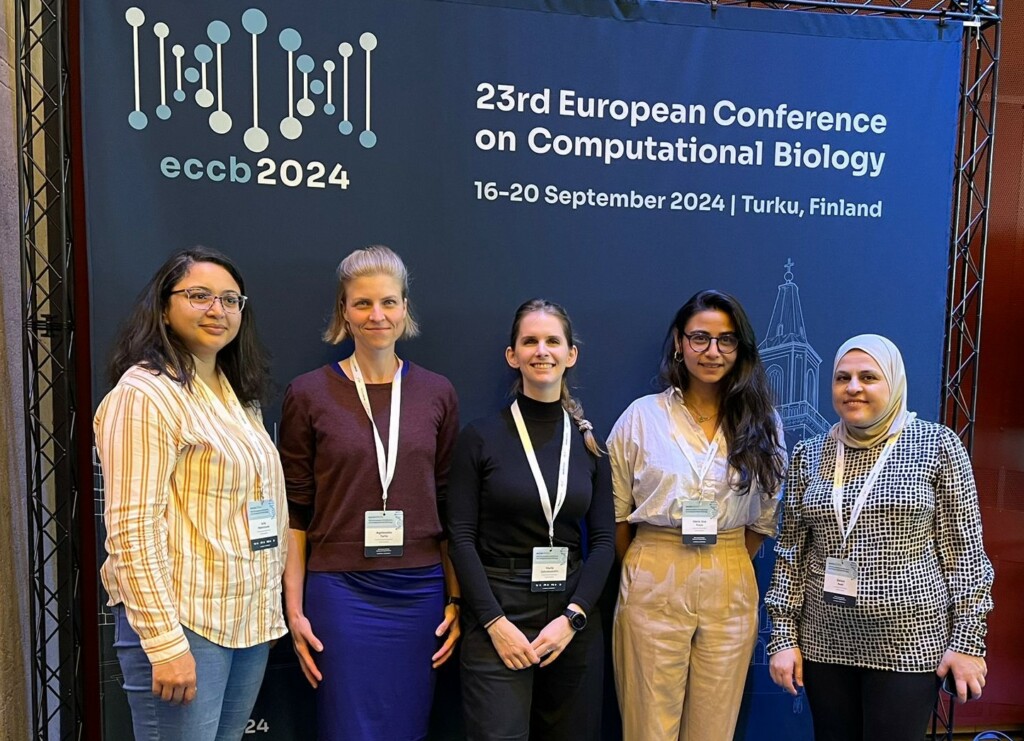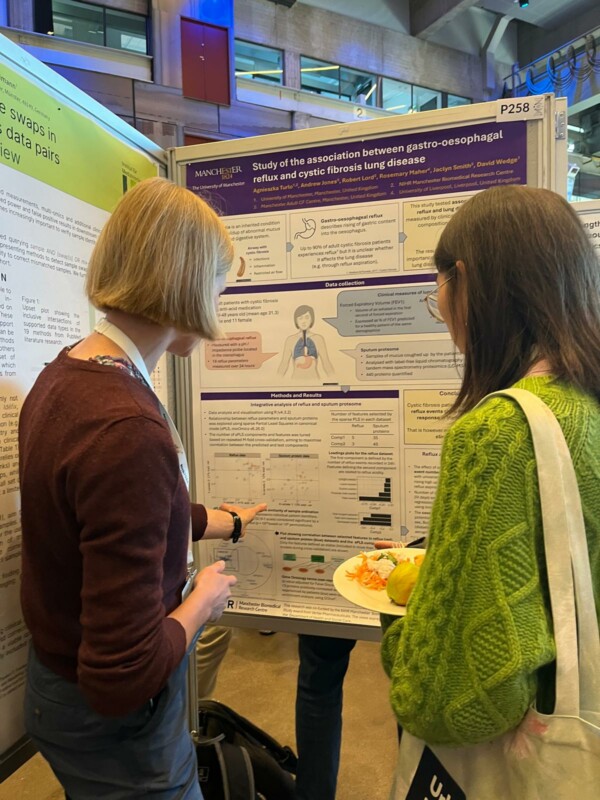The power of data and algorithms for health and science – what Manchester BRC bioinformaticians learned from European conference
Last autumn, five bioinformaticians from the National Institute for Health and Care Research (NIHR) Manchester Biomedical Research Centre (BRC) attended the 23rd European Conference on Computational Biology (ECCB) in Finland.
The conference focused on ‘Data and Algorithms for Health and Science’ and was co-organised by the University of Turku and the CSC–IT Center for Science.
Dr Aggie Turlo, a bioinformatician from Manchester BRC’s Respiratory Theme, along with Dr Arfa Mehmood, Dr Deniz Ece Kaya, Dr Maria Jakobsdottir and Dr Salam Assi from the Next Generation Phenotyping and Diagnostics Theme, attended the conference. Here they share their learning from the event, the posters presented and how they are now applying this learning to other projects across Manchester BRC.

Left to right: Dr Arfa Mehmood, Dr Aggie Turlo, Dr Maria Jakobsdottir, Dr Deniz Ece Kaya, Dr Salam Assi.
We were excited to learn more about the most recent developments and how to apply them to our work analysing medical research data.
Getting up to speed with advances in computational biology and bioinformatics
Research studies generate increasingly larger and more complex data sets. Methods for analysing data need to evolve equally quickly to make the best use of the research results, to advance diagnosis and treatment of health conditions. With hundreds of research papers published every month, it is difficult to stay on top of the broad and quickly evolving field of bioinformatics. We were curious to see what’s new and how other teams approach challenges like the ones we encounter in our everyday work in the Manchester BRC. We often need to adjust existing analysis methods to data obtained from different sample types (e.g. lung or tumour fragments or breath). This is made easier by sharing knowledge with other research groups working with similar sample types or experimental methods and conferences like ECCB are great opportunities for doing that.
Bioinformatics comes in many flavours
Many different subjects and methods fall under the term of bioinformatics! The conference involved poster and oral presentations organised into six themes related to specific data types (genome, proteins, microbiome, single cell), analysing different data types together (data integration), and building infrastructure for the information exchange (ELIXIR programme). There was a diverse line up of keynote speakers, most notably Prof Sarah Teichmann from Cambridge Stem Cell Institute who leads the international initiative of mapping human cell types at single cell resolution, and Prof Fabian Theis from the Institute for Computational Biology in Munich whose group uses AI to model cellular response in single cell research.
Among the presenters were scientists from a wide range of disciplines, including bioinformatics, AI, biology, and medicine, which gave us an insight into different points of view on health research. The poster presentations we delivered at the conference spanned analysis of different data types from cystic fibrosis patients, designing a new software for timing copy number changes in cancer genomes, and comparing different methods for analysing gene expression data in tumour tissue sections.

You can read more about the conference as a whole in this article, published in Bioinformatics journal.
What we learned…
Several important lessons from the conference included:
- Advanced methods of analysing clinical samples (e.g. measuring gene expression in individual cells or intact tissue fragments) are gaining popularity and analysing data produced by these experiments will become an important part of the bioinformatician’s skillset.
- With new methods for data analysis invented at quick pace, it is important to carry out studies comparing novel and established methods (‘benchmarking’) using different datasets. The ‘best’ method may vary depending on the study and sample type under investigation and it is worth taking time to figure out what works for our data.
- There is growing interest in employing AI in medical data analysis, which may be especially useful for interpreting large datasets and simulating complex processes (e.g. response to a drug). While AI models have not entered popular use yet, it is worth keeping an eye on that space!
- The study of microorganisms (microbiomes) is very popular and considered an important part of understanding many diseases, as well as the impact of humans on the environment. Bioinformaticians have a key role in interpreting results of microbiome studies through design of dedicated tools and knowledge exchange within the community.
…and how are we going to use it
A big part of the conference was the introduction of new tools and approaches for addressing specific tasks in data analysis. The requirement for oral presentations (81 in total!) was for the presented work had to have been recently published as a research paper, which means we could immediately start to apply the methods presented. Moreover, we had the opportunity to attend seven satellite workshops that took place ahead of the conference and that involved hands-on tutorials on how to use different pieces of software.
Exploring the different tools and workshops also prompted us to discuss how we can harmonise our working practices and analysis approaches within Manchester BRC’s bioinformatics team. This will become increasingly more important as we start collaborating more across the Manchester BRC. Such collaboration would lead to improving data analysis workflows, as multiple team members would use the same analysis tools and thus contribute to their development. That could result in faster, more robust analysis of medical studies that can inform clinical practice or guide future research programs.
What’s next?
ECCB was a great platform for discussing the latest tools and challenges. Each of us found something applicable to our (rather varied) work. We would recommend ECCB and its global equivalent, the ISMB conference, to other researchers, not only those working exclusively in data analysis. Do not get put off by the ‘computational’ in the conference name – the participation of scientists from different fields made it interesting, and presenters did an excellent job explaining the context of their work.
In July 2025 the joint ECCB/ISMB conference comes to Liverpool. See you there!